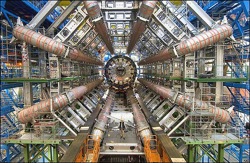 BBC– Dr David Evans: “From conception to design and building this, it’s taken about 20 years.”
BBC– Dr David Evans: “From conception to design and building this, it’s taken about 20 years.”
The Large Hadron Collider has successfully created a “mini-Big Bang” by smashing together lead ions instead of protons. The scientists working at the enormous machine on Franco-Swiss border achieved the unique conditions on 7 November.
The experiment created temperatures a million times hotter than the centre of the Sun. The LHC is housed in a 27km-long circular tunnel under the French-Swiss border near Geneva.
Up until now, the world’s highest-energy particle accelerator – which is run by the European Organization for Nuclear Research (Cern) – has been colliding protons, in a bid to uncover mysteries of the Universe’s formation.
Proton collisions could help spot the elusive Higgs boson particle and signs of new physical laws, such as a framework called supersymmetry.
But for the next four weeks, scientists at the LHC will concentrate on analysing the data obtained from the lead ion collisions.
This way, they hope to learn more about the plasma the Universe was made of a millionth of a second after the Big Bang, 13.7 billion years ago.
One of the accelerator’s experiments, ALICE, has been specifically designed to smash together lead ions, but the ATLAS and Compact Muon Solenoid (CMS) experiments have also switched to the new mode.
Continue reading about Large Hadron Collider Generates ‘Mini-Big Bang’.
© BBC, 2010
Photo by flickr user Image Editor










